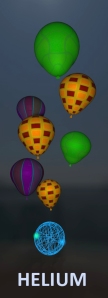Helium
Balloons on standby! Ready to squeak our way through a Helium blog post?
In 1868 Pierre Janssen and Norman Lockyer noticed something unusual about the light coming from our sun during an eclipse. The rainbow of light that comes from our sun is not perfect – there are gaps in the colours (see image). The black lines occur because atoms in the sun absorbs wavelengths of light specific to the type of element – like a fingerprint. This bar code of the sun tells us what it is made of. Some black lines observed in the 1868 solar eclipse did not match the fingerprint of any known element – Jansen and Lockyer had discovered something new and they called it Helium from Helios meaning ‘sun’.
 Helium wasn’t isolated on Earth until 1895 by Sir William Ramsey – several others isolated the same gas that year but Ramsey got in there first. It was thought to be very rare element on Earth because Helium is so light it can escape Earth’s gravitational pull and float out in to space. Then in 1903 miners in Kansas came across a huge underground cache. They tried to light the jet of gas as it escaped from a crack in the ground, but it wouldn’t catch because helium doesn’t react with oxygen, or anything else for that matter.
Helium wasn’t isolated on Earth until 1895 by Sir William Ramsey – several others isolated the same gas that year but Ramsey got in there first. It was thought to be very rare element on Earth because Helium is so light it can escape Earth’s gravitational pull and float out in to space. Then in 1903 miners in Kansas came across a huge underground cache. They tried to light the jet of gas as it escaped from a crack in the ground, but it wouldn’t catch because helium doesn’t react with oxygen, or anything else for that matter.
Helium may have spent its entire life as an element never forming a compound. This sounds like a lonely existence but each atom of helium is quite happy by itself. Certain numbers of protons and neutrons form particularly stable nuclei of atoms, meaning they are very unlikely to decay radioactively. Helium with its two neutrons and two protons in the nucleus is very stable. The two electrons whizzing around the nucleus fill a ‘shell’. This added completeness means helium has no need to borrow or share electrons from other atoms to fill up the shell – this sharing of electrons is how atoms form chemical bonds. Scientists have never been able been able to force helium to react with any other element in the periodic table.
Helium’s refusal to play with the other kids does not mean it is useless and we can ignore it. Helium has two major uses; party balloons and superconductors. Lets start with the balloons. Helium is lighter than air so it makes the balloon float. Helium doesn’t burn because it doesn’t want to form chemical bonds with oxygen so it is safe to have around birthday candles. If you inhale the helium from the balloons it also makes your voice squeak. This is because sound travels faster in helium than air so it raises the pitch of your voice.
Helium becomes more interesting when its a liquid but this only happens at temperatures below -269 degrees C. A cup of liquid helium once stirred will never stop spinning but that isn’t even the weirdest part. Liquid helium creeps. A puddle of liquid helium at the bottom of a container will creep up the sides and over the rim to escape. Some materials when cooled in liquid helium will allow electrons to flow through them with zero resistance – superconductors. In theory this means you could put your laptop in a bucket of liquid helium and the battery would never go flat. It would be difficult to type and the helium would continuously try to escape but you wouldn’t have to worry about losing your charger.
All of this means we use around 7000 tons of helium annually, 150 tons of it are in liquid form in the Large Hadron Collider alone. Once helium is released into the atmosphere it is lost forever. Isolating helium from air is staggeringly expensive. With global reserves estimated at 8.6 million tons (most of which is in the USA) it is not inconceivable that we could one day run out. This would be a sad loss for children’s parties.
Don’t be depressed, next week is Lithium!
@RotwangsRobot
Sun spectra image from NOAO.
Other images by @SciCommStudios


party balloons and…what??? Don’t leave me hanging like this!
No idea what happened there. First blog SNAFU (I’m sure there will be others). All present and correct now.
Sorry.
How happy am I reading about elements? Never have been before – what’s going on?
Question: if it never stops when you stir it – isn’t that perpetual motion?
Its not really perpetual motion as the helium has to stay at -269 degrees C. In reality everything will warm up.
“Helium has two major uses; party balloons and”….
Well what’s the and… or is that back to our squeeky voices in which we’re reading this?
Not again. Half the blog went missing last week but it should all have been reinstated. Looks fine on my laptop. Can you hit refresh and let me know if its still missing?
My fault, I’d not refreshed since I opened the page last week and I’ve only just got round to reading it! All looking fine now.